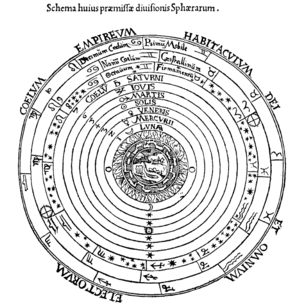- Primum Mobile
-
In medieval and Renaissance astronomy, the Primum Mobile, or "first moved," was the outermost moving sphere in the geocentric model of the universe. The primum mobile was thought to be responsible for the apparent daily movement of the heavens around the Earth, producing the east-to-west rising and setting of the sun and stars. This apparent motion is now known to be due to the rotation of the Earth on its polar axis—a concept that, though known since ancient times (generally ascribed to Aristarchus), was not widely accepted prior to Copernicus. Astronomers believed that the seven naked-eye planets (including the Moon and the Sun) were carried around the spherical Earth on invisible orbs. Beyond them was the sphere of fixed stars, the Primum Mobile, and the Empyrean.
The total number of celestial spheres was not fixed. In this 16th-century illustration, the firmament (sphere of fixed stars) is eighth, a "crystalline" sphere (posited to account for the reference to "waters . . . above the firmament" in Genesis 1:7) is ninth, and the Primum Mobile is tenth. Outside all is the Empyrean, the "habitation of God and all the elect."
See also

This history of science article is a stub. You can help Wikipedia by expanding it.

